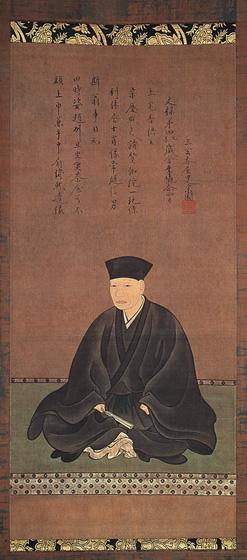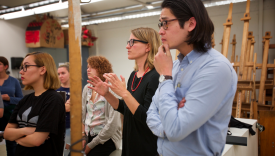
The Way of Tea
Tea Ceremony, or Chado (茶道), is one of the Japanese traditional arts involving ritualistic preparation of tea. Cha (茶) means tea, and do (道) means the way or the path. Thus, Chado is translated as the Way of Tea.
What is the Way of Tea?
The Way of Tea is composed of a series of acts such as building a fire in the hearth, boiling the water, whisking the green tea powder in a tea bowl, and serving it along with some sweets. Simply put, it is an act in which the host invites the guest to share a bowl of tea together. Indeed, it began as a simple act of making and drinking tea. Over the centuries, however, it was influenced by Zen Buddhism philosophy and became a highly stylized form of art.
 In the mid-16th century, the great tea master Sen no Rikyu (千利休, 1522-1591) perfected the procedure of making tea by systematizing the order of movements and standardizing the size of tearoom or tea utensils. His achievement was not only the creation of new modes of tea servings and aesthetics surrounding physical components of tea but also the emphasizing of the spiritual sides, connecting the idea and practice of Zen to the practice of tea. This is called Cha-Zen Ichi-mi (茶禅一味), Zen and tea as a unified whole.
In the mid-16th century, the great tea master Sen no Rikyu (千利休, 1522-1591) perfected the procedure of making tea by systematizing the order of movements and standardizing the size of tearoom or tea utensils. His achievement was not only the creation of new modes of tea servings and aesthetics surrounding physical components of tea but also the emphasizing of the spiritual sides, connecting the idea and practice of Zen to the practice of tea. This is called Cha-Zen Ichi-mi (茶禅一味), Zen and tea as a unified whole.
Rikyu once noted, “tea is enough if it satisfies thirst.” Naturally, tea can provide an immediate remedy to our physiological needs, removing the feelings of dryness in our throats and satisfying hunger. In fact, what Rikyu meant by thirst applies to our mental state—the dryness in our hearts and souls. Rikyu viewed the Way of Tea as a vehicle to attain a spiritual state of selflessness and peacefulness, leading us towards a state of enlightenment.
Rikyu witnessed a time of social and political upheavals, endless battles, riots, plunders, and natural disasters. During this period of warring states, the samurai warriors were running around outside the house, executing their boss’s orders to kill their enemies. One day, a samurai may be at the top of his game, but the next day, he may be six feet under. In this kind of chaotic state, Rikyu sought out the ways to obtain peace of mind through practicing tea, treating it just like Zen meditation. Therefore, a simple act of making and serving tea became a more ritualistic, ceremonial, and stylized performance unlike any other tea drinking culture in the world.
The goal of Way of Tea is to cultivate one’s mind, body, and soul all together through everyday trainings of tea. In such trainings, Rikyu laid out four basic concepts for the tea practitioners to follow: wa (harmony), kei (respect), sei (purity), and jyaku (tranquility).
 Wa means to create a friendly relationship between the host and guest, applicable to a basic rule in human society. It also means that we should be friendly to nature, based on the ideology of human as a part of nature. Our lives are sustained thanks to nature, so we should only take what we need and never more.
Wa means to create a friendly relationship between the host and guest, applicable to a basic rule in human society. It also means that we should be friendly to nature, based on the ideology of human as a part of nature. Our lives are sustained thanks to nature, so we should only take what we need and never more.
Kei means to show one’s respect to others and nature and to be humble at all times. Doing so negates one’s selfishness, and thus, enables one to attain peace of mind.
Sei means to obtain cleanliness both outside and inside. One should wash one’s hands and mouth before entering the tearoom—to attain physical purity—and also empty one’s mind through the act of making and drinking tea—to attain spiritual purity.
Finally, jyaku means to attain calmness in mind so that one is prepared to face anything at all times. This can be only achieved through physical training—practice—of tea.


